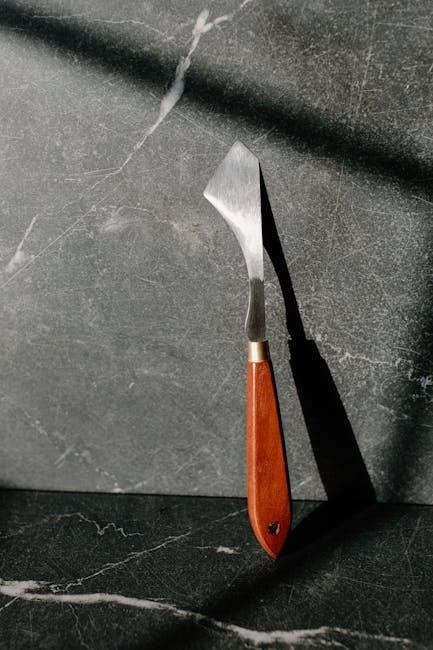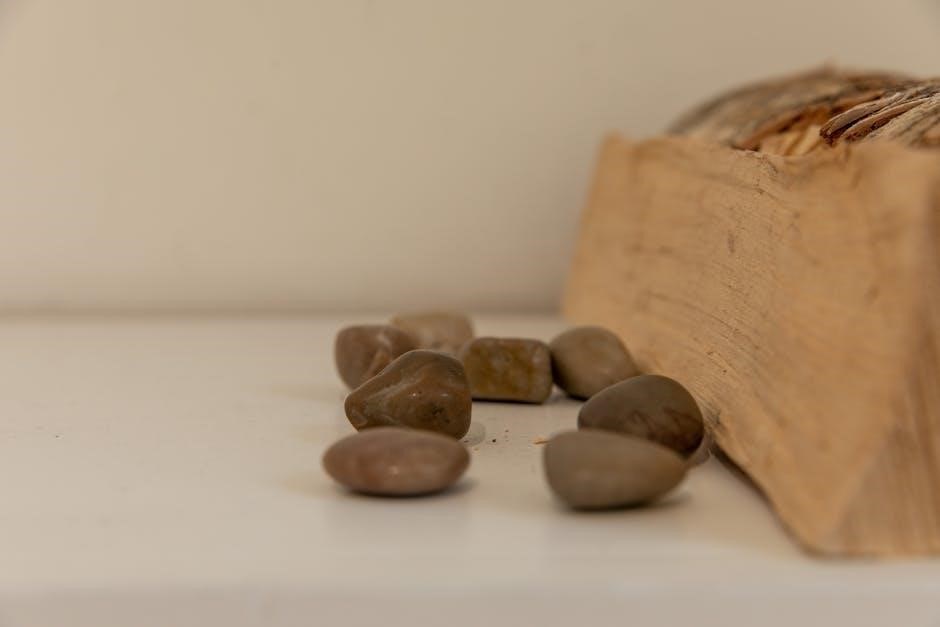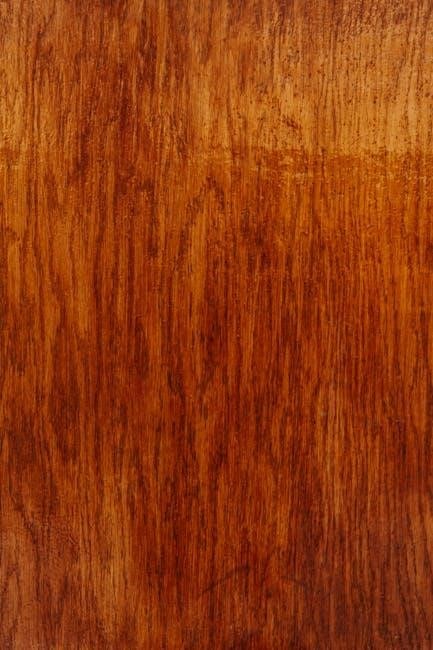A wood hardness chart, often in PDF format, provides a standardized guide to measure wood species’ resistance to wear and denting, aiding in project planning and material selection.
1.1 What is a Wood Hardness Chart?
A wood hardness chart is a comparative guide that ranks wood species based on their resistance to wear and denting, typically using the Janka hardness scale. It provides a standardized measure of hardness, helping users determine the suitability of different woods for various applications. The chart often includes species names, hardness ratings, and sometimes weight or density, making it an essential tool for woodworking, flooring, and construction projects. It is widely available in PDF formats for easy reference and printing.
1.2 Importance of Understanding Wood Hardness
Understanding wood hardness is crucial for selecting the right material for projects, ensuring durability, and predicting performance. Hardness indicates resistance to wear, denting, and damage, essential for applications like flooring, furniture, and construction. Knowing the hardness helps in avoiding costly mistakes, ensuring safety, and optimizing material use. It also guides maintenance and care, making it a vital factor in woodworking and construction industries. A wood hardness chart simplifies this process, providing a clear reference for decision-making.
The Janka Hardness Scale
The Janka Hardness Scale measures wood’s resistance to denting and wear, using a steel ball test, providing a standardized method to compare wood species hardness effectively.
2.1 Definition of the Janka Hardness Test
The Janka hardness test quantifies wood’s resistance to denting and wear by measuring the force required to embed a 0.444-inch steel ball halfway into the wood’s surface. This method provides a consistent, repeatable way to assess wood hardness, enabling comparisons across various species. The results are expressed in pounds-force, with higher values indicating harder woods. This test is widely recognized for its reliability and applicability in woodworking and construction industries.
2.2 How the Janka Test is Conducted
The Janka hardness test involves measuring the force required to embed a 0.444-inch steel ball halfway into a wood sample. The wood is prepared by cutting it to a specific size and ensuring the surface is flat. The steel ball is pressed into the wood using a controlled force until the ball is half submerged. The test is performed on both the tangential and radial surfaces to account for variations in wood grain. The average force required is recorded, providing a standardized hardness rating in pounds-force (lbf). Higher ratings indicate harder wood.
2.3 Industry Standard for Wood Hardness
The Janka hardness scale is the industry standard for measuring wood hardness, providing a consistent method to assess resistance to denting and wear. It aids professionals in selecting appropriate wood for construction, flooring, and furniture. The scale is widely referenced in woodworking and construction, ensuring reliability and comparability across different projects. By standardizing hardness ratings, it simplifies material selection, helping users predict durability and performance in various applications.

Wood Species and Their Hardness Ratings
This section explores the hardness of various wood species, from the hardest like Australian Buloke to softer options like Basswood, based on the Janka scale, ensuring informed material selection for projects.
3.1 Hardest Woods According to the Janka Scale
The hardest woods, like Australian Buloke and Hickory, have Janka ratings exceeding 2,000 pounds, offering exceptional durability and resistance to wear. These species are ideal for high-traffic flooring and heavy-duty applications due to their dense structure and strength. African Padauk, with a rating of 1,725, and Black Locust at 1,700, also rank highly. Their hardness ensures minimal denting and prolongs lifespan in demanding environments, making them top choices for professionals seeking long-lasting results.
3.2 Softest Woods and Their Applications
Softwoods like Basswood and Eastern White Pine have low Janka ratings, making them easier to work with for carving and furniture. Basswood, with a rating of 410, is ideal for intricate designs and woodturning. Aspen, rated at 350, is commonly used for paint-grade projects and plywood. These softer woods are perfect for applications where ease of shaping and lightweight properties are prioritized, offering versatility for craftsmen and DIY enthusiasts seeking manageable materials for various creative tasks and constructions.
3.3 Examples of Common Wood Species and Their Janka Ratings
The wood hardness chart PDF lists species like Red Oak (1,290), Maple (950), and Cherry (995), providing clear Janka ratings. Softwoods such as Eastern White Pine (380) and Basswood (410) are also included, along with harder options like Hickory (1,820). These ratings help users compare durability and workability, making it easier to choose the right wood for projects ranging from flooring to furniture, ensuring optimal performance and aesthetic appeal based on hardness levels.
Applications of the Wood Hardness Chart
The wood hardness chart PDF is essential for flooring, furniture making, and woodworking, guiding material selection based on durability and workability for various projects and applications.
4.1 Flooring and Construction
The Janka hardness chart is crucial for selecting wood in flooring and construction. Harder woods, like Hickory or Brazilian Cherry, resist wear and denting, ideal for high-traffic areas. Softer woods, such as Pine, are better suited for construction where durability is less critical. The chart helps determine wood suitability based on hardness ratings, ensuring optimal material choice for structural integrity and aesthetic appeal in various building projects.
4.2 Furniture Making and Woodworking
In furniture making and woodworking, the Janka hardness chart is essential for selecting wood species. Harder woods, such as Maple or Oak, are ideal for durable furniture, while softer woods like Pine or Spruce may be more suitable for decorative or less stress-bearing pieces. The chart helps craftsmen choose materials that balance strength, workability, and aesthetic appeal, ensuring projects are both functional and visually appealing over time.
4.3 Musical Instruments and Specialty Projects
The wood hardness chart is crucial for crafting musical instruments and specialty projects, where sound quality and structural integrity are paramount. Hardwoods like Maple and Bubinga are favored for their resonance and durability in instruments such as guitars and violins. Softer woods, like Spruce, are often used for delicate or intricate designs. The chart helps artisans select woods that balance acoustic performance, workability, and aesthetic appeal, ensuring optimal results for unique and demanding applications.

Limitations and Considerations
Wood hardness charts have limitations, as they don’t account for factors like moisture content or regional variations, which can affect a wood species’ actual hardness and performance.
5.1 Factors Affecting Wood Hardness Beyond the Janka Scale
Beyond the Janka scale, wood hardness is influenced by factors like grain structure, density, and moisture content. Environmental conditions, such as humidity, can alter wood’s natural hardness. Additionally, regional variations in wood species and growth patterns may result in differing hardness levels. These factors highlight the importance of considering multiple variables when assessing wood durability and performance for specific applications.
5.2 Moisture Content and Wood Density
Moisture content significantly impacts wood hardness, as higher humidity can soften wood, making it more prone to denting. Wood density, measured by weight per board foot, also plays a role, with denser woods generally being harder. These factors, while not directly measured by the Janka scale, influence the overall durability and performance of wood in various applications, emphasizing the importance of controlling moisture levels for optimal results.
5.3 Regional Variations in Wood Hardness
Wood hardness can vary significantly based on regional growing conditions, even within the same species. Climate, soil quality, and growth rates influence wood density and hardness. For example, slower-growing trees in colder climates often produce harder wood compared to faster-growing trees in warmer regions. These variations highlight the importance of considering regional factors when considering Janka ratings for specific projects.
While the Janka scale provides a standardized measure, local variations may result in slightly different hardness levels. This means the actual hardness of a wood species can differ depending on its origin, even if the Janka rating remains consistent. Understanding these regional differences is crucial for accurate project planning and material selection.

How to Read a Wood Hardness Chart
A wood hardness chart, often in PDF format, organizes species by their Janka ratings, measuring resistance to wear. It helps guide material selection and project planning effectively.
6.1 Understanding the Chart Structure
The wood hardness chart is structured to list species by their Janka hardness ratings, from highest to lowest. Each entry includes the wood name, numerical rating, and sometimes density or weight. The chart provides a clear, comparative view of wood hardness, enabling users to quickly identify harder or softer options. It helps in selecting the right wood for projects based on durability and resistance needs, with higher ratings indicating harder, more durable woods.
6.2 Key Metrics and Ratings
The key metrics in a wood hardness chart include Janka hardness ratings, measured in pounds-force, indicating resistance to denting and wear. Higher ratings signify harder woods, while lower ratings denote softer species. Additional metrics like wood density and weight per board foot are often included, providing a comprehensive overview. These ratings help users assess durability, workability, and suitability for various applications, ensuring informed decision-making for projects ranging from flooring to furniture-making.

Printable Wood Hardness Chart (PDF)
The printable wood hardness chart (PDF) organizes wood species by Janka ratings, covering domestic and exotic woods, ideal for quick reference and project planning purposes.
7.1 Benefits of a Printable PDF Chart
A printable PDF wood hardness chart offers convenience and accessibility, providing a clear, portable reference for comparing wood species’ durability and hardness. It simplifies project planning, allowing users to quickly determine the best wood for their needs, whether for flooring, furniture, or other applications. The PDF format ensures consistency and ease of use across devices, making it an essential tool for professionals and DIY enthusiasts alike.
7.2 How to Use the PDF for Project Planning
Using a wood hardness chart PDF for project planning involves selecting wood species based on their Janka ratings. Match the wood’s hardness to the project’s requirements, ensuring durability. For flooring, choose harder woods like hickory. For furniture, medium to hard woods work well. Sort and filter the chart to identify suitable options, ensuring the wood aligns with your intended use and desired aesthetics, optimizing both functionality and design effectively.
Durability and Maintenance
Durability and maintenance are crucial for extending the life of wood products. Harder woods generally require less maintenance, while softer woods may need protective finishes to prevent damage.
8.1 Predicting Wood Durability
Predicting wood durability involves assessing its resistance to wear and environmental factors. The Janka hardness scale helps determine durability, with higher ratings indicating greater resistance to denting and abrasion. Hardwoods like hickory and maple are highly durable, while softwoods may degrade faster. Regular maintenance, such as sealing and polishing, can enhance longevity. Understanding wood hardness and density aids in selecting the right species for long-lasting applications, ensuring projects remain intact over time.
8.2 Maintenance Tips for Hard and Soft Woods
Regular cleaning and drying are essential for both hard and soft woods to prevent moisture damage. For hardwoods, apply sealants or polishes to protect against wear. Softwoods may benefit from protective oils to resist rot and insects. Avoid extreme temperatures and humidity, as these can warp or degrade wood. Polishing periodically maintains appearance and durability, while using the right cleaning products prevents damage to finishes. Proper care extends the lifespan of wood in any application;
Comparing Janka Ratings
Janka ratings compare wood hardness, with higher values indicating greater resistance to wear. Domestic species like Hickory often rank lower than exotic woods such as Australian Buloke, which tops the scale. These comparisons help users select appropriate materials for projects, balancing durability and workability based on hardness rankings.
9.1 Domestic vs. Exotic Wood Species
Domestic wood species, such as Hickory and American White Oak, generally have lower Janka ratings compared to exotic woods like Australian Buloke and African Padauk. Domestic woods typically range from 500 to 2,000 pounds-force, while exotic species often exceed 3,000 pounds-force. This comparison highlights the significant difference in hardness, with exotic woods offering greater durability for high-wear applications. Understanding these variations helps users choose the most suitable material for their projects, balancing cost, availability, and performance.
9.2 Janka Ratings vs. Other Hardness Tests
The Janka hardness test is distinct from other methods like Brinell and Mohs, as it specifically measures resistance to denting and wear using a steel ball. While Brinell tests use a smaller ball and measure indentation depth, Janka ratings are more tailored for woodworking. Mohs scale, used for minerals, isn’t applicable to wood. Thus, Janka remains the woodworking industry standard, providing a reliable comparison of wood species for practical applications in construction and furniture making.
A wood hardness chart is an essential tool for understanding wood durability and suitability for projects, helping professionals and DIYers make informed decisions with confidence.
10.1 Summary of Key Points
A wood hardness chart, often in PDF format, simplifies comparing wood species’ durability and resistance to wear. The Janka hardness scale, measuring force to indent wood, guides material selection for projects like flooring and furniture. Harder woods generally offer greater durability, but factors like moisture content can influence performance. This chart is invaluable for professionals and DIYers, helping them choose the right wood for their needs while considering practical applications and limitations.
10.2 Final Thoughts on Using the Wood Hardness Chart
A wood hardness chart is an essential tool for anyone working with wood, providing clear insights into durability and suitability for various projects. By understanding the Janka hardness scale, users can make informed decisions, balancing strength, cost, and aesthetic appeal. While the chart is invaluable, remember to consider additional factors like moisture content and specific project requirements. Referencing a printable PDF chart ensures you’re always equipped to choose the perfect wood for your needs, every time.
